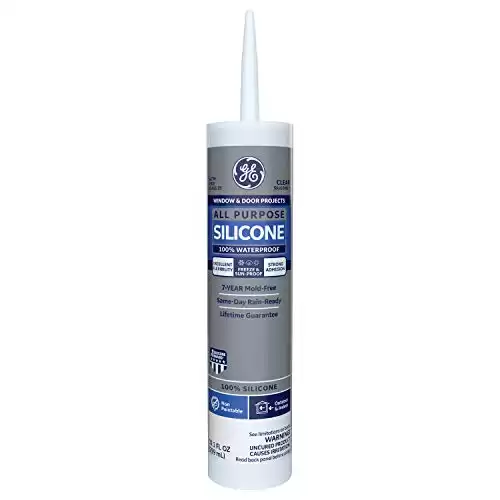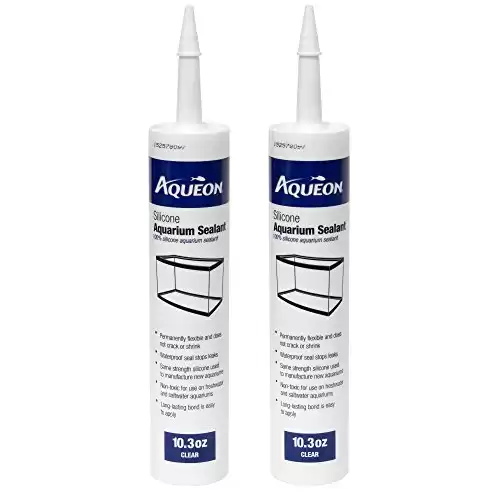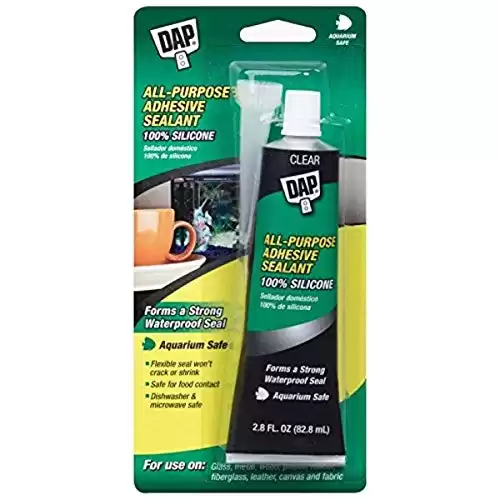Whether you’re building a new aquarium or repairing an old tank, you will need trustworthy and reliable silicone to make sure that there are no leaks and that your tank holds together indefinitely. However, not every silicone product is made with aquariums in mind, so it’s important to know what makes something aquarium-safe while still giving the tightest seal.
|
4.7
|
4.5
|
4.0
|
Keep reading to find out everything you need to know about aquarium-safe silicone and some options that might be best for your tank build or repair!
Key Takeaways
- Aquarium-safe silicone is essential for tank building or repair; ensure it is 100% silicone with no potentially harmful additives.
- Silicone is the preferred sealant for glass aquariums due to its durability and resistance to environmental conditions; it should not be used on acrylic.
- Among the recommended products, options like GE012A All Purpose Silicone and ASI Clear Aquarium Silicone Sealant stand out for reliability, despite potential issues like long curing times and higher costs.
Regular vs. Aquarium-Safe Silicone
Silicone can be used to build or repair aquariums, as well as to secure rocks and driftwood or to make modifications to equipment. It is regularly used alongside types of cement and other glues, but silicone is usually most popular for sealing glass aquariums. While silicones can easily be found in your local hardware store, there are a few things to consider when purchasing a tube with aquarium use in mind.
The problem is that many regular silicones include chemicals and other additives to combat issues that would arise outside of the aquarium environment, like mildew resistance and mold inhibitors. To find a completely aquarium-safe silicone, you need to look for a “100% silicone” label.
It should be noted that silicone does not work for acrylic fish tanks and should be used on glass only.
How Can You Tell if Silicone Is Safe for Aquariums?
100% silicone is completely safe for aquariums as long as there are no sneaky additives. If the product is marked as pure silicone or aquarium-safe silicone, it is safe to use in your fish tank.
As a hobbyist with over 40 years of experience in keeping fish of all types, I’ve had a few tanks spring leaks. Discovering a small puddle beneath your precious tank is undoubtedly alarming, but it can usually be fixed with a little effort and the right product. I’ve always preferred to use aquarium-safe silicone to be on the safe side. That said, on several occasions in an emergency, I’ve resorted to using a regular household silicone product. Thankfully, my fish survived without problems from either a water shortage in their home or the silicone repair I did with a product found in my husband’s DIY box!
If your tank starts leaking, you might want to take a look at this thread on Reddit’s excellent forum. Many users here have suffered from a leaky aquarium and offer some great advice on how to fix the leak, what products work and which don’t, etc. It’s well worth checking out!
It’s worth noting that aquarium-safe silicone products are often more expensive than regular non-toxic brands. So, you can save yourself some cash by using a basic non-toxic brand that works just as well.
How Does Aquarium-Safe Silicone Work?
Silicone is a silicon and oxygen-water-resistant glue that adheres to most surfaces, especially glass. This clear and flexible material is highly resistant to changes in pressure and other environmental conditions, including weather, sunlight, and temperature. Silicone is applied as a liquid gel but gradually cures as a secure tacky putty.
For smaller tanks, it usually takes 24 hours for the silicone to cure. For larger aquariums, it’s best to give as much time as possible for curing to ensure there are no unfinished areas. The curing process must take place outside of water and exposed to oxygen.
Perform a watertight test after the curing to check for leaks before you refill your tank completely.
For aesthetic purposes, clean up any sloppy edges and remove excess silicone.
Summary Table
| Product Name | Pros | Cons | Features | Average Price | Tube Size |
|---|---|---|---|---|---|
| GE Sealants & Adhesives GE012A All Purpose Silicone 1 Sealant | Widely available, strong seal, inexpensive | Labeled as not aquarium-safe, long curing time | 100% silicone, available in clear or white, temperature-resistant | Around $5 - $10 | 10.1 oz |
| Aqueon Silicone Sealant | Trusted brand, quick curing time, multiple sizes | Has a sensitive nozzle, and the product can dry out easily | 100% aquarium-safe, high strength, permanently flexible | Around $10 - $15 | 1 oz, 3 oz, 10 oz, 10.3 oz/2 pack |
| DAP 00688 All-Purpose Adhesive Sealant | Aquarium-safe, good for small repairs, easy to find | Small quantity, relatively expensive | 100% silicone, waterproof, flexible | Around $5 - $7 | 2.8 oz |
| ASI Clear Aquarium Silicone Sealant | Industry-standard, designed for fish tanks, durable | Not beginner-friendly, long curing time, expensive | Non-slump formula, usable on vertical surfaces, non-toxic when cured | Around $12 - $20 | 10.2 oz |
Best Silicone for Use in Aquariums
In this list, we’ve included both generic and aquarium-specific silicone products so you can decide which is better for your setup and budget!
We’ve considered overall reliability, usage, price, and customer reviews when selecting these products for our list.
It’s best to have a layer of silicone as thick as your aquarium glass viewing panes, so it could be more economical to buy a larger tube of the product.
GE Sealants & Adhesives GE012A All Purpose Silicone 1 Sealant, 10.1oz, Clear
- 100% silicone caulk
- For indoor and outdoor use
- Permanently flexible, will not shrink or crack
The GE Sealants & Adhesives GE012A All Purpose Silicone 1 Sealant is probably the most recommended regular silicone for aquarium use. This silicone does best when cured for at least a week but can withstand extreme temperatures and will keep a strong seal for your fish tank.
GE 1 comes in clear and white color options.
If you read the fine print on this sealant, you’ll see that it says “not safe for aquarium use”. Don’t be alarmed! Many hobbyists regularly use this silicone for their tanks without any problems as long as it is given time to cure fully. As long as the tube says 100% silicone without any additives, it should be safe for your fish, corals, plants, and invertebrates.
Note: In recent years, this product has undergone a labeling change that guarantees 7-years mold-free. While it’s strongly believed that the actual ingredients across the rebranding stayed the same, if you want to be cautious, it’s recommended to look into other silicones.
What we like:
- 100% silicone favored by many hobbyists over the years
- Widely found in most hardware departments
- Strong, reliable seal given one-week curing time
- Inexpensive
What could be better:
- Long curing time
- Labeled as “not safe for aquarium use”
Aqueon Silicone Sealant
- High strength silicone creates a waterproof, permanent seal that will not crack or shrink
- Permanently flexible silicone
- Long-lasting bond stops leaks
Aqueon Silicone Sealant is guaranteed to be safe for your fish tank inhabitants. This clear silicone comes in four different packaging options: 1 ounce, 3 ounces, 10 ounces, and 10.3 oz/2 pack. Smaller options are better for attaching decorations or modifying filtration, while the larger tubes will give the quantity needed to construct a tank or make larger changes.
This 100% aquarium-safe silicone is the same grade of strength as that used on new Aqueon tanks and typically cures within 48 hours, though we recommend giving as much time as possible to prevent any accidents.
The tubing and nozzle can be difficult to use if applying too much pressure at once, so make sure to apply only steady pressure. Some hobbyists have also found that the silicone tends to dry up quickly if the cap is not completely fastened.
What we like:
- Trusted aquarium brand for guaranteed success with fish tank application
- Multiple sizes to choose from, with varying nozzle sizes for different purposes
- Quick 48-hour curing time
What could be better:
- Tubing and nozzle sensitive to applied pressure
- Packaging design can cause the silicone to dry out
- Slightly more expensive than generic competitors
Dap 00688 All-Purpose Adhesive Sealant, 100% Silicone, 2.8-Ounce Tube
- Long lasting 100% silicone rubber helps build and repair aquariums
- Waterproof
- Stays flexible
- Won't crack or shrink
DAP 00688 All-Purpose Adhesive Sealant is a good choice of silicone if you need to fix emergency leaks or have smaller tanks or adjustments that need to be made.
This small tube of silicone is guaranteed to be aquarium-safe and can usually be found at your local hardware store.
The main downside of this product is that it comes in small packages, which probably isn’t ideal for larger tank builds in terms of price and quantity. This type of silicone also has a slightly longer curing time than Aqueon silicones, with an estimated time of about 72 hours, and we recommend allowing as much time as possible before filling the tank with water.
What we like:
- Aquarium-safe 100% silicone
- Reasonable curing time of several days
- Smaller packaging for hard-to-reach areas/if large amounts of silicone aren’t needed
What could be better:
- Relatively expensive
ASI Clear Aquarium Silicone Sealant – 10.2 Fluid oz Cartridge
- The bonds are unaffected by continuous immersion in water and, when fully cured, is non-toxic to fish
- ASI Aquarium Silicone Sealant is a non-slump sealant and can be applied to vertical surfaces without flowing or sagging
If you want to assemble an industry-standard aquarium, it doesn’t get much more standard than ASI Clear Aquarium Silicone Sealant; ASI silicones are used on most aquariums you see in stores and come in clear and black.
ASI silicones are specifically designed with freshwater and saltwater tanks in mind, offering durability, strength, and straightforward ingredients. However, this silicone can take a week or more to cure before being able to add water and fish to the aquarium, though this is worth it for such a strong bond.
It is crucial to follow instructions when using these silicones as it can be easy to apply too much at once or unevenly. It is strongly recommended to use gloves as the material can be sticky and also to work in a well-ventilated area as there is often a strong lingering odor. Because this product is so high quality, it is one of the most expensive options on this list.
What we like:
- The aquarium industry-standard silicone
- Silicone designed specifically for fish tank setups
- Built to last with tight seals
What could be better:
- Not completely beginner-friendly
- Long curing time of a week or more
- Difficult material to work with in terms of touch and smell
- Expensive
Conclusion
While you might not be building a tank, fixing a repair, or making modifications to equipment/decorations, aquarium silicone is very convenient to have on hand. If unopened, many silicones will last a few years, during which you hopefully won’t need to use them!
Otherwise, it’s important to consider where you will need to use the silicone, how long you have to wait for curing, color, and price; different silicones come in different sizes, making it easier or harder to reach some areas in the tank, sump, or filter.
As long as the silicone is labeled as 100% silicone without any additives or chemicals, then it should be aquarium-safe. If you have any doubts, there are also a number of aquarium-specific brands that have perfected silicones for aquariums!
If you have any questions about aquarium silicone, how to build a glass fish tank, or have had experience using any of the silicones on this list, don’t hesitate to leave a comment below!









GE Sealants & Adhesives GE012A All Purpose Silicone 1 Sealant is your #1 pick. If you look on the back of the tube it says “not for aquarium use”. How can it be safe then?
Hi Tony!
Yes, this is misleading. However, many hobbyists use this silicone for their aquarium projects and have seen no ill effects. As long as it is 100% pure silicone without any inhibitors, then it is safe for your aquarium. They added the “not safe for aquarium use” due to liability issues as they are not branding it as an aquarium product.
If you would like some reassurance, please see some aquarium forums discussing the product in full.